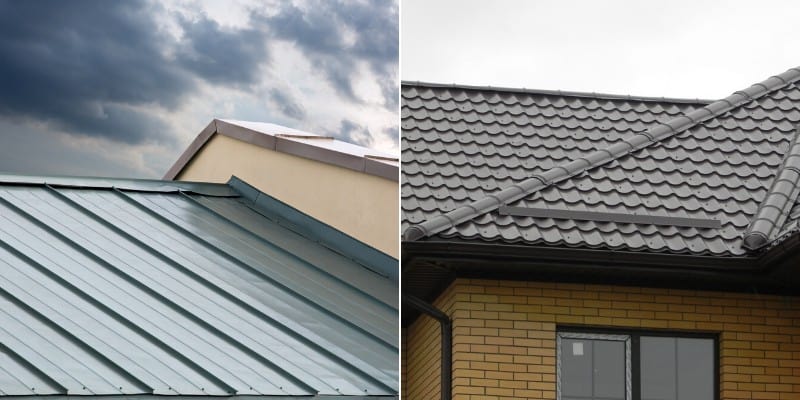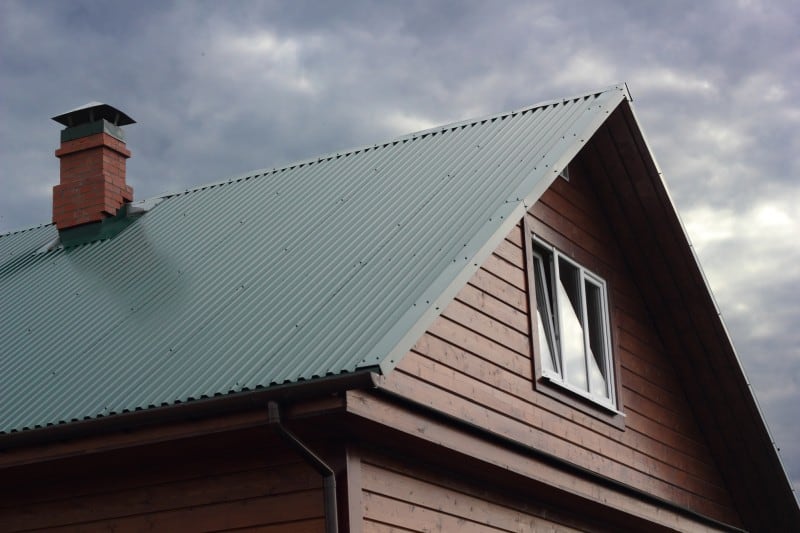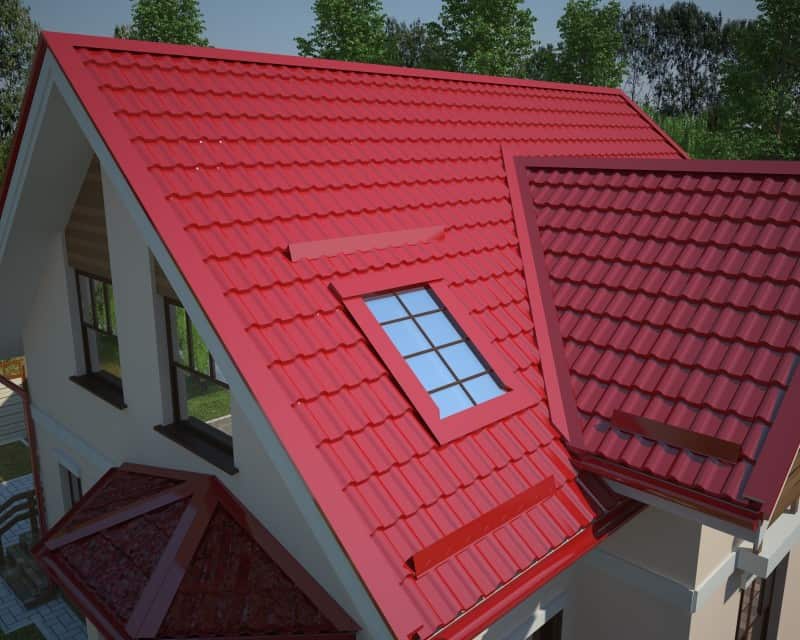Once relegated to rural areas where more barns and silos populated the land than community housing developments, the metal roof also has deep roots in military circles, which is why nations like the U.S., Australia, India and New Zealand were early adapters of this roofing material.

The brainchild of British architect/engineer Henry Palmer, this strong, lightweight, easily transportable, corrosion-resistant material was adopted by builders and roofers as early as the 1840s.
By the 1900s, metal roofs had solidified this material’s place in architectural history by becoming a piece of our cultural identity.
In fact, some types of corrugated and non-corrugated metal sheets install in almost the same way as tiles and shingles: overlapping multiple sheets form the most waterproof roof of all the roofing materials on today’s market.
The fabrication of metal roofs is most often accomplished using a process called roll forming, a highly-automated way to speed up production and reduce production costs.
But a metal roof isn’t the solution for every building on the planet and there are as many pros as there are cons when making a decision to use metal over alternative materials.
Types of Metal Roofs (Material)
Back in the day, the only metal roof choices were either corrugated or non-corrugated metal.
These days, material choices run the gamut from steel and aluminum to copper and zinc. Steve Collins of the Bridger Steel Company names 5 metals that are currently being used for roofs and he offers contractors and consumers this commentary on each of them:
- Copper is extremely long-lasting, though pricey, so if you prioritize aesthetics, you’ll open your wallet wide.
- Aluminum resists salt water corrosion so for folks living in areas where there’s salt in the atmosphere, aluminum is an ideal choice.
- Zinc also resists corrosion and competes with copper for the longest-lasting roof material. That said, zinc isn’t likely to cost as much as copper.
- Steel comes in 3 variations: Galvanized, galvalume and weathering steel, each of which has merit depending upon the roofing look you’re trying to achieve.
- Tin is still around, but it’s not used as often as it was prior to WWII. These days, you might have to special order it if you have your heart set on tin.
Advantages of Metal Roofing

Let’s see some pros of metal roofs for homes:
- These roofs last forever; as long as 70 years (perhaps longer).
- Metal is energy efficient. You could save up to 25-percent on your energy bills.
- Because metal roofs are reflective, they don’t absorb heat.
- Even the harshest environments and weather conditions won’t compromise metal roofs.
- Enjoy a variety of metal choices for affordability, style and performance.
- Maintenance is a breeze; no annual cleaning and maintenance required.
- Metal roofs save homeowners time because they don’t have to resort to power washing, staining or spraying.
- Metal roofs are the epitome of sustainability and the choice of homeowners eager to protect the environment.
- Metals are 100-percent recyclable and ideal surfaces for solar panel mounting.
- Precise measuring and cutting means there’s little waste during fabrication.
- Metal is one of the most fire-resistant roof options on the market; it’s rated Class-A.
- Stylish and contemporary, metal adapts to all types of looks and comes in many colors and styles.
- Metal roofs don’t require pre-install structural assessments because metals are much lighter than other materials.
- Enjoy thick/high gauge metal options that ensure maximum protection from environmental damage.
- Metal roofing can increase the value of a home, upping its resale value by a dramatic 85.9-percent.
- Due to its fire resistance, you will probably pay less for your homeowners insurance policy.
- Warranties on metal roofs are longer; 30- to 50-year coverage is not uncommon.
- Consumers can choose between vertical panels with interlocking seams or metal shingles.
- Metal roofs don’t attract lightning. If struck, a bolt can’t trigger a fire as it would if it struck shingles.
- Metal roofing is impervious to rot and insect damage, so your roof will likely stay termite-, mildew- and mold-free.
- Yes, metal works as well on sloped roofs as it does on flat ones.
- You can recycle your metal roof. Try doing that with traditional shingles!
- You don’t have to remove your old roof unless your local government requires it.
Disadvantages of Metal Roofing
Although metal roofs are great, they come with several cons as well so let’s see these below:
- While metal roofs are fire-resistant, they’re not fireproof.
- Not every homeowner likes the look of metal roofs on homes.
- Expect higher install and material costs for most metals.
- Metal roofs can be scratched and dented, leaving marks not noticeable on asphalt shingles.
- Metal roofs are not always the best material choice for folks living in areas prone to hail storms.
- Metal roofs expand and contract in reaction to temperature extremes.
- Proper installation requites a metal roof specialist. Not every contractor has been trained to roof with metal.
- Standing on top of metal roofs tempts fate. One wrong move on these slippery surfaces can cause a slip and fall injury that could result in permanent disability.
- You could lose sleep during thunderstorms. Some people find the sound romantic; you may find it annoying.
- If you remove your original roof, factor in this additional cost when calculating your budget.
- Roof vents are more obvious on metal than they are on shingles, so if you prefer vents to “blend in,” metal may not be your best choice.
Cost of Metal Roofing

Once you see all of the numbers we’re about to hit you with, you might think you need a calculator, but relax.
These are averages based on research done fairly recently and as a homeowner you likely know that labor and material costs can fluctuate wildly based on market and material availability.
That stated, here are some of the costs you will want to know to help you make an informed decision about which metal roof type makes the most sense for your structure without emptying your bank account.
- -The average cost of a metal roof in 2020 runs between $9,545 and $16,582, but that’s just a ballpark figure.
- -Given dwelling size differences and material availability, your contractor is likely to bill you at the rate of between $5 and $14 per square foot if you want the install done while these market rates prevail.
- -Labor costs associated with all metal roof installs averages between $2.30 and $5.80 per square foot. This may not take into account unusual angles and/or roof features.
- -The cost of asphalt shingles runs between $1 and $4.25 per square foot, so a metal roof may not be as expensive as you once imagined once you compare.
- -Add between $4 and $5 per square foot for underlayment that adds to the longevity and integrity of a metal roof.
Metal roof costs by material type
- – Aluminum roofs will set you back between $3.25 and $5.75 per square foot.
- – Copper roofs are pricey; you’ll spend between $14 and $22 per square foot.
- – Go bare bones and a corrugated metal roof will run a modest $1.80 to $2.50 per square foot.
- – Standing seam metal roofs cost between $4 and $12 per square foot.
- – Sturdy steel metal roofs are relatively affordable at from $3.35 to $4.50 a square foot.
- – Tin roofs come with the widest price range at between $3.25 and $14.65 per square foot.
- – Zinc metal roofs, like standing seam roofs, cost $5.65 to $11 per square foot to install.
Can metal roofing be installed over shingles?
Yes it can, but you need to check with your municipal zoning board to make sure that local codes don’t prohibit doing it.
Further, your community may also have codes in place that require a full tear-off rather than a partial one.
Plenty of homeowners have had great success leaving their old roofs in place, but in some cases, you could be looking at trouble.
Failing to remove shingles could come at a price if those shingles have deteriorated to such an extent, mildew, mold, moisture and other toxic hazards have built up.
If you discover that your existing roof is in a bad condition, topping it with a new metal roof could backfire on you.
Is there a solution? It’s going to cost but if you don’t want to remove your existing roof, specify a vented metal roof when you contract with your roofer and request furring strips to raise the metal up so it allows those toxins to escape thanks to this clever venting roof style.
Can you paint a metal roof?
As long as you are willing to take proper safety precautions and follow a prep process that takes into account the unique nature of metals, why not? Follow these 4 steps and you can do it yourself if you’re handy.
Step #1: If your roof is brand new, experts suggest allowing it to “weather” for 6 months before you paint. If you can’t wait, wash off the film applied during the galvanizing process using a 50-50 dilution of vinegar and water.
Next, power wash the roof at a pressure of around 2,500 pounds per square inch to get rid of other agents applied to the metal when it was manufactured. No power washer? Scrub every inch of the roof with a water/trisodium phosphate solution.
Step #2: Buy both a primer and top coat manufactured exclusively for metal surfaces. Some manufacturers recommend acrylic latex paint; others suggest oil-based alkyd paint which requires an undercoat of galvanized metal primer. Primers inhibit rust and help the paint-to-metal bonding process.
Step #3: Stay safe. Slick metal roofs are extremely dangerous, which is why — in addition to proper ventilation and eye protection gear — you need shoes that can help you walk on the roof without falling for the duration of the job. If your roof pitch is steep, danger could be compounded. A harness tied to a safety line may be the insurance you need to feel confident about undertaking this project on your own.
Step #4: An airless sprayer will get the job finished faster and more evenly than using a brush and/or rollers, and you won’t have to stand on the roof as long as you would were you wielding less sophisticated paint tools. Don’t tackle the job on a day that wind is blowing for obvious reasons.
Metal roof maintenance
The thicker the sealants and coating applied at the metal at the factory, the longer your roof can get by without undertaking tiresome cleaning tasks.
But having invested time, money, energy and other resources to install a metal roof – and understanding that low maintenance is a major reason to choose metals – that doesn’t mean your roof couldn’t use a an overall cleaning from time to time. Products made for this task are everywhere you look, or rely upon vinegar or soap and water.
If you want change your roof color, that’s a different matter. Use a polymer coating to restore the roof surface to its former condition while changing the entire look of your building.
Dark colors are harder to cover than light ones, so if you’ve got a red roof and the color is impregnated into the metal, a light roof color may not be your best option.
Whatever you decide to do, make sure you don’t scrape or otherwise mar your metal roof by using abrasive materials when you tidy things up.
Found a scratch on the roof that ruins the look? Clean it up with a rag and mineral spirits, then use touch-up paint. Consulting an expert is always a good idea before you proceed with any of these beautification projects, so having one on speed dial can’t hurt.
More Resources
https://www.corrugatedmetalroofing.net/history.html
https://www.bridgersteel.com/blog/5-types-of-metal-roofing-materials-pros-cons
https://www.bridgersteel.com/blog/pros-and-cons-of-metal-roofing
https://modernize.com/roof/types/metal
https://www.thespruce.com/truths-about-metal-roofing-for-homes-1821959
https://homeguides.sfgate.com/paint-galvanized-metal-roof-sherwinwilliams-97939.html
Related Posts
- What Type of Plywood is used for Roofing? Size and Thickness Guide
- Advantages and Disadvantages of Solar Roof Vents for Homes
- 10 Different Types of Snow Guards for Metal Roofs
- Advantages and Disadvantages of Roof Ridge Vents for Homes
- 5 Unique Roof Upgrades to Consider for Your Home
- Pros and Cons of TPO Roofing – Cost, Advantages, Disadvantages
Thank you for your input and expertise on metal roofing. Helpful.
Hi Cheri, you are very welcome.
Have a great day.
It was really interesting when you stated that insect damage and rot are some things metal roofing can resist. These are two things I hear homeowners struggle with a lot, so I can expect to have to deal with them myself down the line. I’ll make that easier by having a roofing expert help me get some metal for sure.